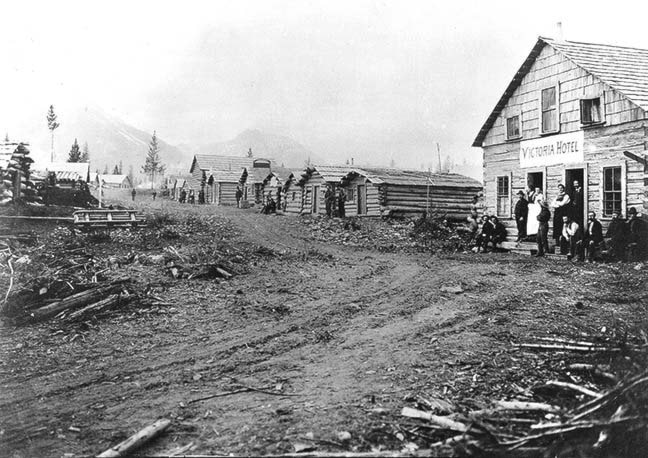Jim Cameron
The coroner's jury convened for seven hours before returning the verdict:
"That the said Steven Morgan, Joseph Sengala and William Robinson came to their deaths on Thursday, the 22nd day of May, 1902, at or about the hour of 7:30 o'clock in the afternoon, in what is known as numbers two and three mines, situated on Coal Creek, near the town of Fernie ... the property of and worked by the Crows Nest Pass Coal Company, Limited; 'That we, the said jury, find the initial cause of the explosion being at a point in number two mine aforesaid, not clearly defined, and that said initial cause extended from the said undefined point throughout the greater portion of Number 2 and 3 mines, coal dust being the conveying medium; and we find in consequence that the inadequate method of watering and removing of the dust left the mine in such a condition to be dangerous..."
The exact point and cause of the explosion may have been undefined but the result was not. For those outside the mine it was a massive blast of fiery coal dust that rose upwards of 1,000 feet above the fan house, the roof of which was never seen again. For Messrs Morgan, Sengala, and Robinson it was posthumous justice, little help that it may have been to them. The death of three men was bad enough, but what made this a disaster was the death of the 125 other men at work in the mine that evening. Not all men, for that matter; Will Robertson (so named in the newspaper accounts but likely the William Robinson of the coroner's investigation), was 13 years old, one of a number of teenagers to die that day. It remains the third worst mine disaster in the history of Canada, and that's saying something, given the extremely dangerous coal mining conditions of the day and the regular and numerous deaths and injuries to the miners.
The town of Coal Creek, built along the waterway of the same name, was only a few miles east of Fernie. It came into being in the 1890s, nestled tightly upon the hillsides of a chiseled valley laden with coal and, for a time, housed over 1,000 residents. Little more than log huts at first, it soon boasted churches clubs and saloons, all attended by the Slavs, Scandinavians, Welsh, Italians and English who worked side by side in the number 2 and 3 mines. It was a gritty, hard-working community and on that day in May, from fathers to sons, brothers to brothers, boys to men, an almost unbelievable portion of the male population simply disappeared. Of the estimated 150 workers only 22 escaped.
 The Coal Creek Collieries in Aug., 1926 (Photo Louis Denison, City of Vancouver Archives CVA 1477.)
The Coal Creek Collieries in Aug., 1926 (Photo Louis Denison, City of Vancouver Archives CVA 1477.)
.
In a stroke of fate Bruce Stewart, formerly of Cranbrook, exited the mine just moments before the blast to attend to some equipment repairs. He lived. S.J. Marsh, another former Cranbrook man, did not. A faded blueprint in the Fernie city hall archives shows dots representing the men who died as they worked alone, in pairs, in clusters, some seemingly untouched in death, killed by the concussion of the explosion, suffocated or poisoned by the deadly methane gas afterdamp that followed; others obliterated completely or so badly mutilated as to be unidentifiable and some, it is believed, simply never found. The rescue work began minutes after the blast but was severely hampered by the presence of lingering gases. Rescuers went in, worked until they were overcome, were carried out and revived and went in once more.
Although the company immediately halted all communication from the mine, rumours spread and tensions ran high among the citizens of Fernie and Coal Creek, fanned by the fact that the inspector of mines had toured the site two days previously and declared it safe. The Cranbrook Herald reported of the fate of Fernie Police Constable Stevens who was said to have remarked that he was sorry that there had not been 200 more men at work when the explosion occurred. The local miners responded by calling at the jail, demanding that Stevens be produced and then, forming two lines from the 500 or so present, forced the constable to remove his uniform and badge and walk between the two rows. He was then escorted to the railroad track and told to head out of town. Whether or not Constable Stevens deserved the banishment he was undoubtedly lucky to be let go unharmed in what was surprisingly the only rebellious act that occurred. Of course, many of those who may have rebelled were dead and many others in shock.
The mere logistics of dealing with so many deaths proved impossible for the town of Fernie and both Cranbrook and Nelson were called upon to supply coffins. The small St. Margaret's Cemetery on the outskirts of Fernie was quickly cleared of trees as grave after grave was dug and numbered to accept the bodies of the miners. Saturday, May 24 -what would normally have been a town celebration of Empire (Victoria) Day - saw over 30 separate funerals performed as coffin after coffin passed through the streets.
The Crows Nest Coal Company agreed to pay all funeral expenses and provide relief against all immediate want and suffering and hastened to re-open the mines (which suffered little damage) as soon as possible. The town of Coal Creek remained until the 1950s when the mines were sealed. Today little remains of the collieries or the town of Coal Creek where, in one mighty blast, 128 miners were hurled into eternity on that fateful day.
janusthenandnow@shaw.ca
